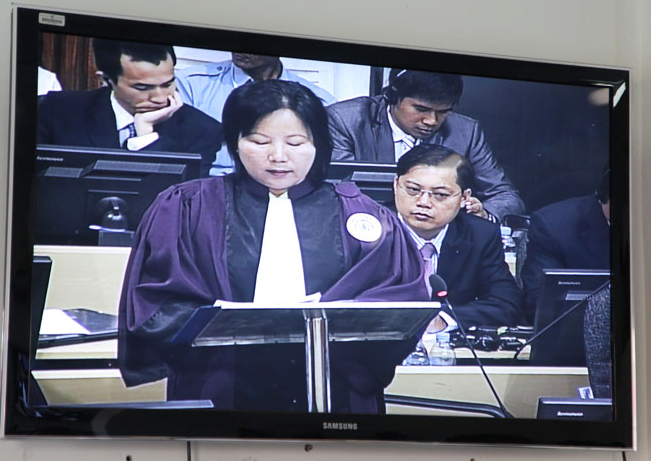Ed note. I’m pleased to introduce Faine Greenwood. Faine is a journalist, photographer, and new media specialist residing in Cambodia with a particular interest in the applications of technology and the Internet in Southeast Asia. She recently completed a year working as a reporter and editor at the Cambodia Daily newspaper.
Phnom Penh, Cambodia – A landmark trial of former Khmer Rouge leaders began this week at the Extraordinary Criminal Chambers of Cambodia outside Phnom Penh. Students, saffron-clad monks, civil parties and average citizens arrived by bus, tuk tuk, and motorbike to pack the public courtroom and watch as the prosecution delivered its opening statements to the court, which was established after a 2003 agreement between the Cambodian government and the United Nations.
This was a seminal moment in Cambodian’s decades long quest to come to terms with the horrors of the Khmer Rouge regime. “Case 002” as it is simply known is hoped to bring some margin of justice to the three Khmer Rouge leaders who ruled Cambodia from April 1975 to January 1979, when between 1.7 to 2 million Cambodians died during one of the most horrific genocides of the modern era.


Case 002 will not be an easy battle, inside the courtroom and out of it. Ieng Sary has unequivocally stated that he will not speak in the court proceedings, while Ieng Thirith, a potential fourth defendant and former Minister of Social Affairs, was declared mentally unfit to stand trial due to a diagnosis of dementia and Alzheimers. Although the ruling has been appealed, it is currently unclear if she will walk or not.
Charges read against the defendants this morning included crimes against humanity, murder, extermination, slavery, deportation, “grave” breaches of the Geneva Convention, imprisonment, and torture. Charges of genocide have also been levied against the three defendents, regarding the systematic persecution and extermination of Cambodia’s Cham and Vietnamese minorities.


“I will never forget one amputee without arms or legs writhing like a crippled worm,” describes witness Francois Ponchaud, author of the book Cambodia: Year Zero. Another witness described seeing bodies maimed by dogs lying along the road, not far from the site of today’s war tribunal chambers.
Ms Leang, on behalf of witnesses, also described horrific conditions in Cambodia’s northwestern “zone” during the time of the defendant’s peak power. Survivors described anywhere from 10 to 80 people dying of starvation a day at work sites, their bodies piled in an open pit. One witness claims to have seen neglected patients at a Khmer Rouge “hospital” cutting the flesh from corpses lying beside them, boiling it, and eating it.
The Khmer Rouge also, according to co-prosecutor Leang, waged systematic warfare against Cambodia’s culture and its predominant Theravada Buddhist religion. “The Khmer Rouge eliminated the Khmer culture that connects us and makes us human,” Ms Leang said, describing the special persecution of Buddhist monks. Monks were threatened with death if they did not derobe, often told that their “livers would be cut out and fried for food” if they did not comply. Pagodas and places of worship were turned into prisons, storage areas, and execution centers. Khmer Rouge leaders described monks as “blood sucking parasitic worms.”
Forced marriages were also addressed by Ms Leang, blowing apart the popular Khmer Rouge myth that sexual abuse was not an inherent aspect of their so-called people’s revolution. According to the co-prosecutor’s statement, the Khmer Rouge leadership, determined the Cambodian population must grow to between 20 and 30 million, organized thousands upon thousands of forced marriages, in ceremonies that often involved hundreds of people – who often had never met – at a single time.
Women were described as being treated as “war booty,” handed off to injured Khmer Rouge soldiers as rewards. KR cadres forced women to consummate the forced marriages at gunpoint, and would often observe the new “couples” having sex. “There was one good thing about the Khmer Rouge,” a former soldier was said to have observed. “If you wanted to marry a woman, and she didn’t want to marry you, the Khmer Rouge would make her.”
Ms Cheang also addressed the Khmer Rouge so-called “security centers,” which functioned as secret prisons, among them the infamous S-21 torture prison, now a harrowing museum in downtown Phnom Penh.
As the Khmer Rouge leaderships’ paranoia about supposed CIA, KGB and Vietnamese spies intensified, and as things grew worse under the regime’s rule, more and more ethnic minorities were purged – as was anyone who attracted the ire of party leadership.
According to the co-prosecutor’s statements, people were sent to prison, tortured, and killed for offenses as arbitrary as smoking a discarded cigarette butt, “being sick too often,” and stealing food to feed their families. Over 200 such “centers” are known to have existed during the Khmer Rouge era: S-21, the largest, could hold up to 3,000 people at a time.
Case 002 is also deeply important because of what it means for the future of the besieged War Tribunal, which has experienced more than its fair share of scandal and criticism in the past year, including the resignation of international investigating judge Siegfried Blunk.
One thing is painfully clear: some margin of justice for the victims of the Khmer Rouge era atrocities, and the future of this long-in-coming tribunal, hinges on the success or failure of this historical trial. Beyond the millions of individual victims in Cambodia, the successful prosecution of war criminals from the 1970s would show that even though memories may have faded and political circumstances changed, impunity is no option for war crimes.
